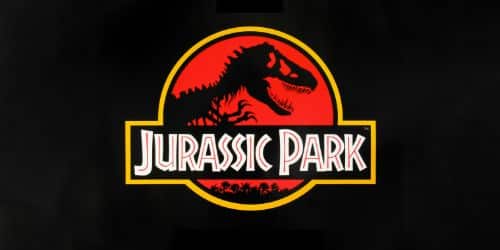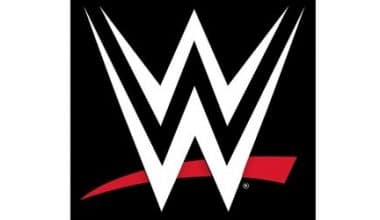Jurassic Park is a vast media franchise that encompasses a number of films, books, and other types of entertainment. It is based on a book that was released in 1990 and portrays the story of a failed amusement park with live dinosaurs. But that is just half the story. This article will provide a detailed history of Jurassic Park as well as the evolution of the logo.
What Exactly is Jurassic Park?
The name Jurassic Park refers to a renowned franchise developed by Michael Crichton in 1990. Novels and short tales, multiple movies (the first of which was produced by Universal Studios in 1993), animated series, video games, toy brands, and several thematic amusement park attractions are all part of the franchise.
The History of the Jurassic Park Logo
The Jurassic Park visual identity is still based on the logo that was made for the brand in 1993, but the current version is an updated and stronger badge that replaces the traditional red and black color palette with a cold metallic combination, giving it a sense of danger and sharpness.
1993 – 1997
The original Jurassic Park logo was a bloody-red circle in a black and yellow frame, with a dull black dinosaur skeleton on the left side of the emblem. The badge’s lower section was crossed by a huge black rectangular banner with the same framing and powerful white wording with red lines.
1997 – 2001
In 1997, the logo was changed. “Jurassic Park” was changed to “The Lost World” and “Jurassic Park” stayed as a tagline. The main aspect of the visual identity, its insignia, was given some black accents and a “cracked” appearance. The badge’s outline has also been changed, with three rings—two blacks and one thick yellow in the center.
2001 – 2015
With the release of the third part of this well-known series, the logo was changed again, and this time the changes were bigger. The badge’s black, red, and yellow color palette was replaced by gray and red, with gray having gradient metallic hues and red being dark and sinister. The dinosaur was done in a silver-gray scheme, as was the rectangular badge (dark gray background and white and red inscription, with three diagonal lines stylized as claw scratches, placed on the right from the wordmark and representing the third installment of the franchise).
2015 – 2017
In 2015, the red background of the badge was changed to a blue gradient, and the badge got a third dimension. The words “Jurassic World” on the banner were in the dark, and the dinosaur skeleton was a dark gray color. The logo appeared scary and dramatic, perfectly matching the franchise’s plot and core theme.
2018
The color palette was redesigned in 2018, and the dark, three-dimensional badge is now done in a monochromatic palette with gradient gray and black colors and a white wordmark. The new version looks more confident and professional than the original, even though the main symbols and shapes are still the same as they were at the beginning.
2022
The logo for the 2022 film “Jurassic Park: Dominion” is based on the original film’s logo. They too employed a red-and-yellow circle, but this time it was smaller. The original skeleton is also present, but in a chopped state: only the head and paws are visible due to the circle’s reduced size.
The film’s wordmark is written in the same way as the original title, with the exception of “Dominion,” which is written in tall and narrow capital letters. A large black rectangle served as the background for both sections.
Modern designers have given the symbol a new look and given it a new color. It is no longer gray, blue, or red, but rather a bright yellow with an orange gradient around the edges. The middle is the brightest, as if it is lit from behind. Because of the color scheme, the round base looks like a piece of amber with chipped and shattered corners. The silhouette of a tyrannosaurus appears in the center, turned to the left. It has an inconsistent orange-brown tint with dark and pale dots. The artists are, as before, detailing all of the bones, including the vertebrae, ribs, head, and jaws. Sharp teeth and claws are also shown in great detail.
By the way, the makers of Jurassic World: Dominion replicated the iconic symbol in the film. This Easter egg can be found at the end, when the T-Rex is preparing to enter the fight against the Giganotosaurus. He passes by a ring-shaped fountain at some point, and his profile is seen in the same way as in the Jurassic Park emblem.
The Symbol’s Evolution
Sandy Collora redesigned the logo before the film’s release in 1993. Using Chip Kidd’s Tyrannosaurus Rex skeleton as a guide, she changed the shape of the bones to make them less thin and long. Collora encased the Tyrannosaurus in a circle and overlaid the wordmark. Finally, there was a line of palm trees beneath the wordmark.
The Jurassic Park Logo Font and Color
Before the first movie came out, Sandy Collora changed the logo based on Chip Kidd’s skeleton of a Tyrannosaurus Rex. She stretched and thinned the bones, positioned the prehistoric predator’s figure in a circle, and added a palm tree strip. The remaining variations followed the specified path. They were the same size and shape. While the movie’s title and dinosaur species remained the same, the artists did alter the dinosaur’s texture and appearance.
The font style, on the other hand, is identical to that used on the book cover. Michael Crichton wrote it.
Down the line, Doug Olena, an assistant professor at Evangel University, created the new version. The font has a connection to Star Wars.
The color scheme was continually changing: at first, it was red and black, then gray and red, and lastly, blue and gray.
The History of Jurassic Park
Jurassic Park, subsequently renamed Jurassic World, is an American science fiction media franchise established by Michael Crichton that centers on a disastrous attempt to create a dinosaur theme park. It all started in 1990, when Universal Pictures and Amblin Entertainment bought the pre-publication rights to Michael Crichton’s novel Jurassic Park.
The book was a triumph, as was Steven Spielberg’s cinematic adaptation in 1993. The picture was re-released in 3D theaters in 2013, and was chosen for preservation in the United States National Film Registry by the Library of Congress in 2018 as “culturally, historically, or aesthetically important.” The Lost World, a sequel novel published in 1995, was adapted into a film in 1997. Jurassic Park III (2001) and subsequent films in the series are not based on the novels.
The fourth film in the series, Jurassic World, the second trilogy of films began in 2015. The movie was a huge success. It was the first to make more than $500 million worldwide in its first weekend, and it went on to make more than $1.6 billion, making it the third highest-grossing movie at the time. It was the second-highest-grossing film of 2015 and is now the seventh-highest-grossing film of all time.
Read Also: ALLSTATE LOGO: The Story Behind Allstate’s “Good Hands”
When adjusted for inflation, Jurassic World is the franchise’s second highest-grossing picture, trailing only Jurassic Park. Jurassic World: Fallen Kingdom (2018), a sequel, made over $1.3 billion globally, making it the third Jurassic film to do so. It is presently the 17th highest-grossing picture of all time and the third highest-grossing film of 2018. Jurassic World Dominion, the final film in the trilogy, was released in 2022. It has earned more than $1 billion globally, making it the second-highest-grossing picture of 2022. Jurassic World Dominion became the fourth film in the franchise to gross more than a billion dollars.
Since 1993, the movie has inspired various computer games, comic novels, and water rides at Universal Studios theme parks. The 2019 miniseries Lego Jurassic World: The Legend of Isla Nublar is one of numerous Jurassic World-themed Lego animations. Jurassic World: Camp Cretaceous, an animated series developed by DreamWorks Animation, aired on Netflix from September 2020 to July 2022. By the year 2000, the franchise had earned $5 billion, making it one of the highest-grossing in media history.
The Jurassic Park film franchise is also one of the highest-grossing film series of all time, with over $6 billion in worldwide box office receipts.
Background
The Jurassic Park franchise is about resurrected dinosaurs that prey on mankind. The dinosaurs are cloned as theme park attractions via genetic engineering. The ancient DNA is extracted from mosquitoes that sucked the blood of dinosaurs and subsequently became preserved in amber, retaining the DNA. The scientists then use frog DNA to patch up the gaps in the genome. Despite the fact that the films are mostly set on Central American Pacific coast islands, Jurassic World: Fallen Kingdom (2018) finds dinosaurs roaming the globe, including the United States mainland.
The film series is renowned for its use of animatronics and computer-generated graphics to recreate dinosaurs.
The first film was hailed for its dinosaur effects and sparked increasing interest in paleontology, while its modern representation of dinosaurs altered the public’s understanding of dinosaurs.
Paleontologists complained that later movies often didn’t use the latest fossil discoveries because they wanted to keep the story going from one chapter to the next.
In keeping with recent discoveries, Jurassic World Dominion (2022) introduces winged dinosaurs.
InGen
International Genetic Technologies, Inc. (InGen) is the fictitious company in charge of dinosaur cloning. It is based in Palo Alto, California, and has one location in Europe, according to the novels.
Nonetheless, the majority of InGen’s research was conducted on the fictitious islands of Isla Sorna and Isla Nublar in Costa Rica.
While the first novel implied that InGen was just one of many small genetic engineering start-ups in the 1980s, the events of the novel and film revealed to a select group that InGen had discovered a method for cloning dinosaurs, which would be used on an island theme park attraction.
InGen was well established as the entity behind the park in the first novel, although the first film stressed the Jurassic Park brand’s simplicity. The name InGen appears in the film—on computer screens, helicopters, and so on—but it is never spoken. The corporate identity of InGen is more evident in the second film. InGen and all of its intellectual property have been absorbed by the Masrani Global Corporation by the time Jurassic World takes place.
InGen is compared to other “sleazy groups” in Beacham’s Encyclopedia of Popular Fiction.
Other authors see the company’s purchase of a baby T. rex in The Lost World: Jurassic Park as a reference to the greedy businessmen in the 1933 movie King Kong. InGen, according to Ken Gelder, is “resolutely secretive,” much like the tax firm in John Grisham’s 1991 novel The Firm.
Biosyn
Biosyn Corporation (or Biosyn for short) is InGen’s corporate adversary in the novels. The corporation is being investigated for industrial espionage in the genetics industry. Lewis Dodgson, a Biosyn employee, assists the business in its theft of corporate secrets. Biosyn is interested in purchasing InGen’s dinosaur DNA because it believes the animals can be used for a number of purposes, including hunting trophies and pharmaceutical test subjects.
Dodgson appears only briefly in the first film, and his employer is not named.
Biosyn, on the other hand, appears in a number of video games.
The company makes its film debut as Biosyn Genetics in Jurassic World Dominion (2022). Dodgson has become the company’s CEO by the time the film takes place. Dr. Henry Wu, a geneticist, and Dr. Ian Malcolm, a mathematician, now work at Biosyn as the company’s in-house philosophers.
With dinosaurs roaming the globe and being captured by governments, Biosyn has a contract to hold the animals at its headquarters in Italy’s Dolomites mountain region. In addition to conducting medicinal research on dinosaurs, the firm has kidnapped 14-year-old orphan Maisie Lockwood and released huge locusts to consume its competitors’ crops. This conspiracy is foiled and revealed to the public towards the end of the film.
Colin Trevorrow, the film’s director, described Biosyn as a firm with thousands of employees that have the finest intentions but feel deceived by Dodgson after learning of his acts.
The Isla Nublar
Isla Nublar is a made-up island in Central America that shows up in the first book, its movie version, Jurassic World, and Jurassic World: Fallen Kingdom. Its name means “Cloud Island” in Spanish, according to the novel. The tropical island, 120 miles west of Costa Rica, is home to a dormant volcano. Isla Nublar is the location of Jurassic Park, a dinosaur theme park proposed by InGen in the first novel and film, but it fails to open after the animals escape. In the novel, the Costa Rican government declares the island hazardous and has it napalmed; in the film series, the island survives until the Jurassic World trilogy.
Masrani Global Corporation effectively implemented the theme park concept in Jurassic World. But by the end of the movie, because of what happened with the Indominus rex, the island is once again full of dinosaurs.
In Jurassic World: Fallen Kingdom, Mount Sibo erupts and destroys Isla Nublar when it comes back to life.
Several Hawaiian islands, including Oahu and Kauai, served as Isla Nublar in the films.
Some of the filmings were also done on sound stages, in California for the first film and in Louisiana for Jurassic World.
Sorna, Isla
Another fictitious Central American island is Isla Sorna, commonly known as Site B. It is located 87 miles south of Isla Nublar and 207 miles west of Costa Rica. It serves as the primary setting for the second novel, its cinematic adaptation, and the third feature. InGen did much of its dinosaur research on Isla Sorna. After being raised here, the dinosaurs were relocated to Isla Nublar and housed in a visitor-only lab. Isla Sorna is much larger than Isla Nublar and has a variety of climates, such as tropical, highland tropical, and temperate rainforest. It is claimed at the end of the second film that Isla Sorna has been established as a biological sanctuary for the creatures.
Although the other islands do not play a role in the novels or films, Isla Sorna is part of a five-island chain known as Las Cinco Muertes (The Five Deaths).
Isla Sorna’s status is not mentioned in Jurassic World or Jurassic World: Fallen Kingdom, but a promotional website for the latter film claims that the island’s ecology collapsed after illegally cloned animals were placed there. For Jurassic World’s opening, the dinosaurs still living were transferred to Isla Nublar, leaving Sorna vacant.
Read Also: PUNISHER LOGO: The True Meaning of the Controversial Logo, Revealed!!!
Jurassic World Dominion depicts the confrontation of two mature Tyrannosaurus from Isla Sorna with the Tyrannosaurus from Isla Nublar. Ramsay Cole adds in the same film that the dinosaurs from Isla Sorna, as well as those from Isla Nublar, had been moved to BioSyn’s valley. Henry Wu shows Maisie Lockwood film footage from 1986 in which the island appears momentarily.
Humboldt County, California, served as the major site for sequences set on Isla Sorna in the second film, giving it a woodland environment.
Filming also took place on sound stages at Universal Studios Hollywood, as well as on Kauai for a beach scene.
The third film uses Oahu and Kauai to represent Isla Sorna, as the first did for Isla Nublar. A jungle set was also constructed on a Universal Studios sound stage.
When did Chip Kidd make the Jurassic Park logo?
Chip Kidd debuted the first version of the Jurassic Park logo in 1990, just a few months after he began working on it. The in-house design team worked on the badge until 1993, when it was formally adopted.
How Did the Original Emblem Appear?
Chip Kidd noted that, after receiving the brief, the first thing he did was go to the Museum of Natural History and look at the bones. Then he bought a book with dinosaurs in it. He grabbed a photograph of a dinosaur, put it in a Photostat machine, and began drawing the beast on tracing paper.
All of this appears to be stupidly simple: a book and a piece of tracing paper. And yet, that is how the distinctive logo that is recognized all over the world was born.
Who drew the Jurassic Park logo?
The iconic Jurassic Park logo, first seen in the early 1990s, was designed by a young American artist Chip Kidd and slightly refined by the Universal Pictures team to appear more confident and intense on television.
What dinosaur is in the Jurassic Park logo?
The dinosaur on the Jurassic Park logo is a massive and fearsome Tyrannosaurus Rex, one of the most well-known dinosaurs noted for its size and violent temperament.
What are the colors in Jurassic Park?
The dark and dramatic logo for the Jurassic Park franchise is done in black, red, white, and yellow. The white and yellow parts make the image easier to read and stand out.
Related Articles
- DISNEYLAND LOGO: History and Evolution
- BEST PARK: All You Need to Know and Extra
- WHAT IS PATAGONIA LOGO: Meaning, Font, and History
- YELLOWSTONE LOGO: Meaning, Font, and Channel
- ORACLE LOGO: Meaning, Font, and How It Got Its Name






